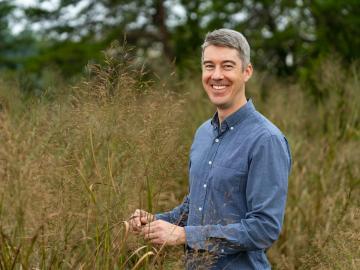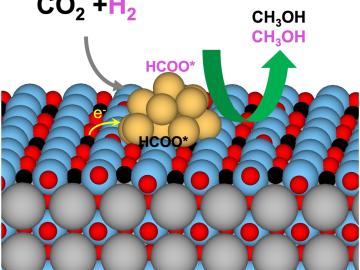Filter News
Area of Research
News Type
Date
News Topics
- 3-D Printing/Advanced Manufacturing (2)
- Artificial Intelligence (7)
- Big Data (5)
- Bioenergy (2)
- Biology (2)
- Biomedical (2)
- Biotechnology (1)
- Buildings (4)
- Chemical Sciences (6)
- Clean Water (2)
- Climate Change (8)
- Composites (2)
- Computer Science (5)
- Critical Materials (3)
- Decarbonization (5)
- Energy Storage (5)
- Environment (7)
- Fusion (1)
- Grid (1)
- High-Performance Computing (5)
- Isotopes (2)
- ITER (1)
- Machine Learning (3)
- Materials (5)
- Materials Science (3)
- National Security (2)
- Net Zero (1)
- Neutron Science (2)
- Partnerships (2)
- Physics (1)
- Polymers (2)
- Quantum Computing (1)
- Simulation (3)
- Statistics (2)
- Sustainable Energy (4)
- Transportation (4)
Media Contacts

The United States has enough biomass potential to produce 35 billion gallons per year of aviation biofuel by 2050, a new report confirms. ORNL’s John Field provided biomass feedstock production expertise to the report focused on the role of the bioeconomy in U.S. decarbonization strategies.

Oak Ridge National Laboratory scientists ingeniously created a sustainable, soft material by combining rubber with woody reinforcements and incorporating “smart” linkages between the components that unlock on demand.

Building innovations from ORNL will be on display in Washington, D.C. on the National Mall June 7 to June 9, 2024, during the U.S. Department of Housing and Urban Development’s Innovation Housing Showcase. For the first time, ORNL’s real-time building evaluator was demonstrated outside of a laboratory setting and deployed for building construction.

Vanderbilt University and ORNL announced a partnership to develop training, testing and evaluation methods that will accelerate the Department of Defense’s adoption of AI-based systems in operational environments.

ORNL scientists develop a sample holder that tumbles powdered photochemical materials within a neutron beamline — exposing more of the material to light for increased photo-activation and better photochemistry data capture.

ORNL researchers used electron-beam additive manufacturing to 3D-print the first complex, defect-free tungsten parts with complex geometries.

A technology developed by Oak Ridge National Laboratory works to keep food refrigerated with phase change materials, or PCMs, while reducing carbon emissions by 30%.

Scientists have uncovered the properties of a rare earth element that was first discovered 80 years ago at the very same laboratory, opening a new pathway for the exploration of elements critical in modern technology, from medicine to space travel.

A team of scientists led by ORNL found an unconventional way to improve catalysts made of more than one material. The solution demonstrates a path to designing catalysts with greater activity, selectivity and stability.

Researchers at ORNL are developing battery technologies to fight climate change in two ways, by expanding the use of renewable energy and capturing airborne carbon dioxide.




